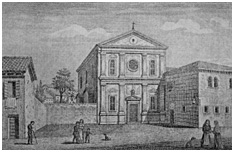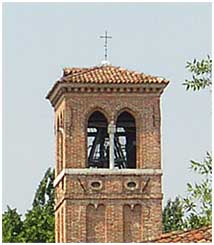THE CHIESA DI SANTA MARIA MADDALENA (CHURCH OF ST. MARY MAGDALENE),
Via Casa di Ricovero - Treviso |
| |
| |
In the history of Treviso, in the first decades of 15th century,
we may find information about a Church dedicated to the cult of St. Mary Magdalene situated where
today there is Porta St. Tomaso (Gate of St. Thomas).
The original
church, belonged to Gerolimini friars, was destroyed in 1511 during the War of Cambrai; in that
place the Porta San Tomaso (Gate of St. Thomas) was built using the same bricks for war requirements. |
| |
|

Chiesa di Santa Maria Maddalena 1846 - Antonio Nani’s engraving.
(Biblioteca Comunale di Treviso) |
 |
After a decade, the building works of
today Chiesa di Santa Maria Maddalena (Church of St. Mary Magdalene) began by Fabrizio delle Tavole’s services, disciple of Palladio.
In 1576 the construction ended with dedication of the church to St. Mary Magdalene, how it is written on a plaque, found lately
indoors. In 1772 the Ursuline sisters took possession of the church and its convent.
Unlike many Trevisans Churches, this wasn’t the victim of the Napoleonic laws of 1806 because it was
a vicarious church of the Chiesa di Santa Maria Maggiore (Church of St. Maria Maggiore). The convent was converted into rest home. |
| |
|
In 1971-72 some restoration works
brought to original sobriety the church.
If we see its fašade from the outside, the building
remember us the fašade of Church of St. Gaetano for its shape
and its simplicity, while over the main door there is a seventeenth-century fresco representing
the patron saint praying, it is almost deleted by time and by carelessness unfortunately. |
| |
The indoor space of Chiesa di Santa Maria Maddalena (Church of St. Mary Magdalene)
- as many other Trevisans churches - is not very wide and developed in one hall with presbytery and two
Lady Chapels; then there are other two chapels on every side of the Church. On the walls of nave
and of presbytery there are some paintings portraying the Biblical events as "Il passaggio del Mar
Rosso" (The crossing of Red Sea), "Il Vitello d’oro" (The golden calf), "Il Banchetto in casa
del fariseo" (The banquet at Pharisee’s house), all works made by Simone Forcellini in 1600,
while "La risurrezione di Lazzaro" (The Lazzaro’s resurrection) was probably made by Antonio Molinari. |
 |
|
|
| |
| |
Two niches accommodate the statues by Giovanni
Melchiorri, precursor of Canova in pediment on background wall over side altars, these two
statues were made in 1700 and they represent The Hope and The Faith.
There is the ancona
(made by Paolo Veronese or by his school) is known as "Noli me tangere" on main altar, it represents
Risen Christ appearing to Maddalena. |
| |
On left altar there is an ancona by
Carletto Caliari, Paolo Veronese’s song; it portrays The Crucifixion, while on ancona of right
altar there is another ancona representing The Holy Family, made probably by G. B. Canal.
When we enter, on the right side we may see an altar with an ancona with the picture of Benedetto
XI by Jacopo Marieschi (18th century), it was in the Chiesa di San Bartolomeo (Church of St. Bartholomew) some century before
and then it was brought to Chiesa Santa Maria Maddalena (Church of St. Mary Magdalene) and it was fitted in a new frame. |
| |
 |
 |
The restoration works let to find a large
grating on the right side; in the end of 18th century and the beginning of 19th century it divided the believers
from nuns and from convent girls during the masses. Thus they could be present at the ceremonies without being
seen during the services in the Church.
The bell tower is admirable for its singleness: it is made by rough
bricks from the outside. A series of pilasters fling the bell tower upright; two series of ring-shaped ornaments
and the belfry with two Gothic double lancet windows.
On the left: the bell tower of the Chiesa Santa Maria Maddalena (Church of St. Mary Magdalene).
|
|
| |


